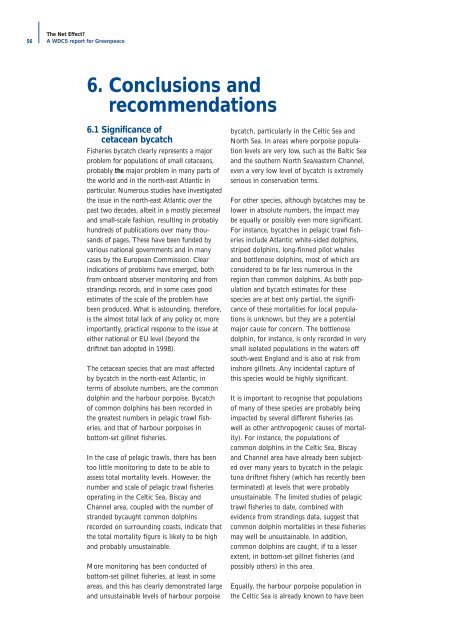The Net Effect? - Whale and Dolphin Conservation Society
The Net Effect? - Whale and Dolphin Conservation Society
The Net Effect? - Whale and Dolphin Conservation Society
Create successful ePaper yourself
Turn your PDF publications into a flip-book with our unique Google optimized e-Paper software.
56<br />
<strong>The</strong> <strong>Net</strong> <strong>Effect</strong>?<br />
A WDCS report for Greenpeace<br />
6. Conclusions <strong>and</strong><br />
recommendations<br />
6.1 Significance of<br />
cetacean bycatch<br />
Fisheries bycatch clearly represents a major<br />
problem for populations of small cetaceans,<br />
probably the major problem in many parts of<br />
the world <strong>and</strong> in the north-east Atlantic in<br />
particular. Numerous studies have investigated<br />
the issue in the north-east Atlantic over the<br />
past two decades, albeit in a mostly piecemeal<br />
<strong>and</strong> small-scale fashion, resulting in probably<br />
hundreds of publications over many thous<strong>and</strong>s<br />
of pages. <strong>The</strong>se have been funded by<br />
various national governments <strong>and</strong> in many<br />
cases by the European Commission. Clear<br />
indications of problems have emerged, both<br />
from onboard observer monitoring <strong>and</strong> from<br />
str<strong>and</strong>ings records, <strong>and</strong> in some cases good<br />
estimates of the scale of the problem have<br />
been produced. What is astounding, therefore,<br />
is the almost total lack of any policy or, more<br />
importantly, practical response to the issue at<br />
either national or EU level (beyond the<br />
driftnet ban adopted in 1998).<br />
<strong>The</strong> cetacean species that are most affected<br />
by bycatch in the north-east Atlantic, in<br />
terms of absolute numbers, are the common<br />
dolphin <strong>and</strong> the harbour porpoise. Bycatch<br />
of common dolphins has been recorded in<br />
the greatest numbers in pelagic trawl fisheries,<br />
<strong>and</strong> that of harbour porpoises in<br />
bottom-set gillnet fisheries.<br />
In the case of pelagic trawls, there has been<br />
too little monitoring to date to be able to<br />
assess total mortality levels. However, the<br />
number <strong>and</strong> scale of pelagic trawl fisheries<br />
operating in the Celtic Sea, Biscay <strong>and</strong><br />
Channel area, coupled with the number of<br />
str<strong>and</strong>ed bycaught common dolphins<br />
recorded on surrounding coasts, indicate that<br />
the total mortality figure is likely to be high<br />
<strong>and</strong> probably unsustainable.<br />
More monitoring has been conducted of<br />
bottom-set gillnet fisheries, at least in some<br />
areas, <strong>and</strong> this has clearly demonstrated large<br />
<strong>and</strong> unsustainable levels of harbour porpoise<br />
bycatch, particularly in the Celtic Sea <strong>and</strong><br />
North Sea. In areas where porpoise population<br />
levels are very low, such as the Baltic Sea<br />
<strong>and</strong> the southern North Sea/eastern Channel,<br />
even a very low level of bycatch is extremely<br />
serious in conservation terms.<br />
For other species, although bycatches may be<br />
lower in absolute numbers, the impact may<br />
be equally or possibly even more significant.<br />
For instance, bycatches in pelagic trawl fisheries<br />
include Atlantic white-sided dolphins,<br />
striped dolphins, long-finned pilot whales<br />
<strong>and</strong> bottlenose dolphins, most of which are<br />
considered to be far less numerous in the<br />
region than common dolphins. As both population<br />
<strong>and</strong> bycatch estimates for these<br />
species are at best only partial, the significance<br />
of these mortalities for local populations<br />
is unknown, but they are a potential<br />
major cause for concern. <strong>The</strong> bottlenose<br />
dolphin, for instance, is only recorded in very<br />
small isolated populations in the waters off<br />
south-west Engl<strong>and</strong> <strong>and</strong> is also at risk from<br />
inshore gillnets. Any incidental capture of<br />
this species would be highly significant.<br />
It is important to recognise that populations<br />
of many of these species are probably being<br />
impacted by several different fisheries (as<br />
well as other anthropogenic causes of mortality).<br />
For instance, the populations of<br />
common dolphins in the Celtic Sea, Biscay<br />
<strong>and</strong> Channel area have already been subjected<br />
over many years to bycatch in the pelagic<br />
tuna driftnet fishery (which has recently been<br />
terminated) at levels that were probably<br />
unsustainable. <strong>The</strong> limited studies of pelagic<br />
trawl fisheries to date, combined with<br />
evidence from str<strong>and</strong>ings data, suggest that<br />
common dolphin mortalities in these fisheries<br />
may well be unsustainable. In addition,<br />
common dolphins are caught, if to a lesser<br />
extent, in bottom-set gillnet fisheries (<strong>and</strong><br />
possibly others) in this area.<br />
Equally, the harbour porpoise population in<br />
the Celtic Sea is already known to have been

















